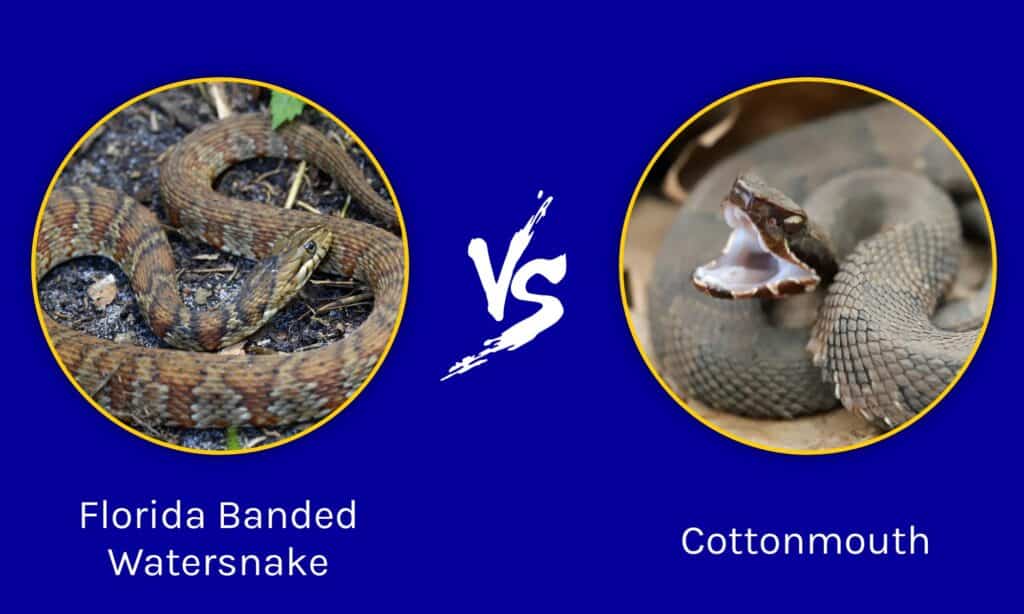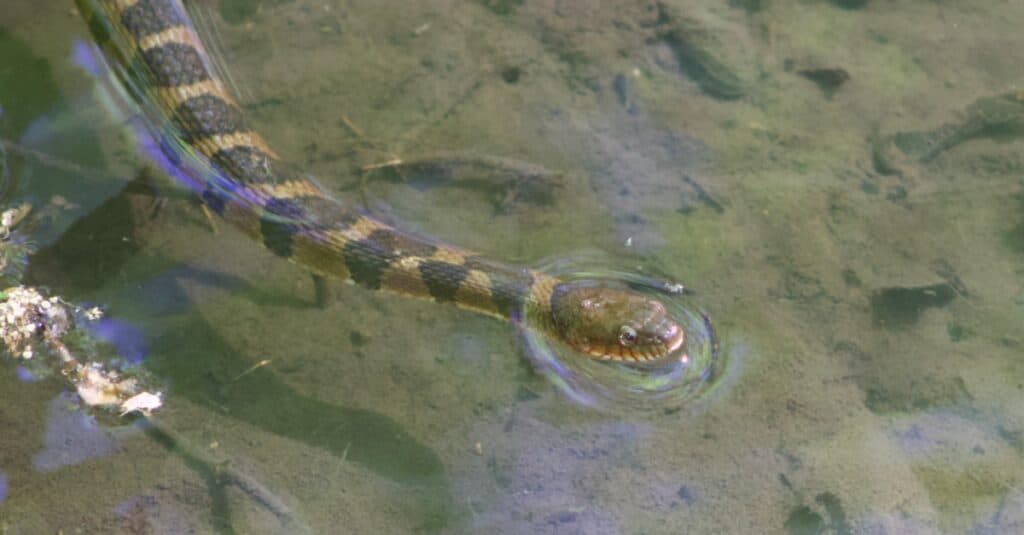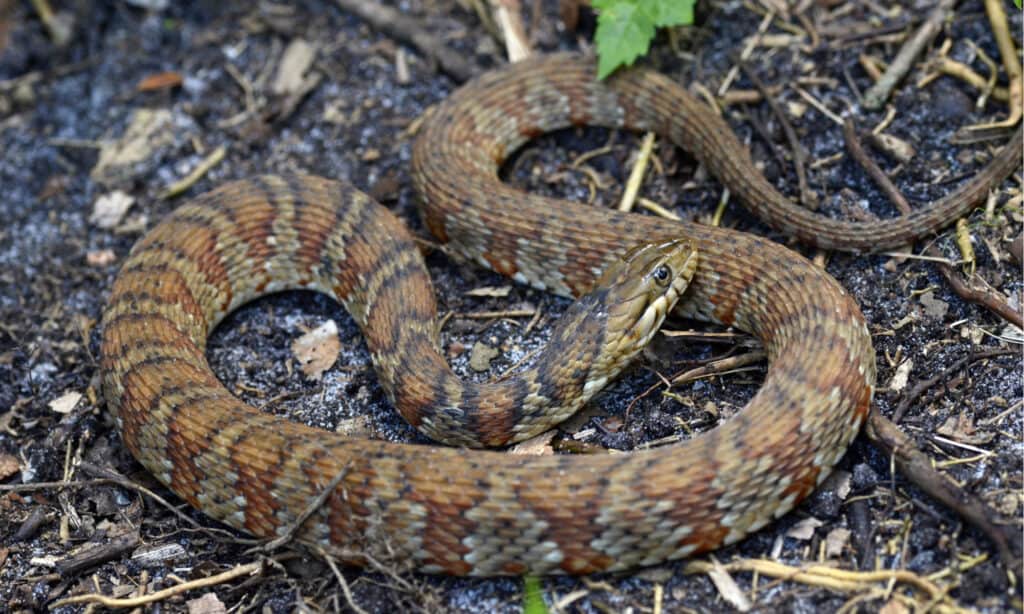If you live in the southeastern United States, there’s a good chance you’ve run into either the Florida banded watersnake, or the cottonmouth, or both. But, only one of these species is venomous, so it’s important to be able to differentiate between the two. Florida banded watersnakes (Nerodia fasciata pictiventris) are a type (subspecies) of banded watersnakes, or simply southern watersnakes. Cottonmouths (Agkistrodon piscivorus) are also called water moccasins.
Here, we’ll discuss the biggest differences between cottonmouths and Florida banded watersnakes, starting with their looks. We’ll take a closer look at where each species lives, and what kind of habitat they prefer. Then, we’ll analyze their distinct behaviors, and what makes the two species unique. We’ll go over their diets, and finally, take a look at which species is venomous. By the end, you’ll know which snake you should look out for, and how to tell the two apart.
The Key Differences Between Florida Banded Watersnakes and Cottonmouths

The biggest difference between Florida banded watersnakes and cottonmouths is that Florida banded watersnakes are nonvenomous. While both snakes enjoy aquatic habitats, they also have appearance differences. Cottonmouths are heavier and have more elliptical pupils while Florida banded snakes have round pupils.
Yet, these are just a few of the more notable differences between these two snakes, let’s dive into more detail below!
Florida Banded Watersnake Vs Cottonmouth: Appearance
Out of the two snakes, cottonmouths are the bigger species. While Florida banded watersnakes rarely exceed 3.5 feet, cottonmouths can grow up to four feet long. Cottonmouths are a much heavier snake too, which is evident in the relative thickness of their bodies in comparison to the body of the Florida banded watersnake. Additionally, banded watersnakes have round pupils, while cottonmouths have elliptical pupils, like a cat’s eye. And, banded watersnakes lack the heat-sensing pits behind their nostrils that mark cottonmouths as members of the pit viper family, along with rattlesnakes and copperheads.

Banded watersnakes are excellent swimmers
©iStock.com/Dalene Capps
As far as coloring, both species range anywhere from yellow-brown to red-brown. Older snakes of each species tend to be darker and less vibrant. Young cottonmouths even have a bright yellow-tipped tail which they use to attract prey. The biggest difference in coloring between the two comes from their striped patterns. Florida banded watersnakes have thick, dark brown stripes, while cottonmouths have irregular, thinner bands.
Florida Banded Watersnake Vs Cottonmouth: Habitat
Cottonmouths and banded watersnakes live throughout the coastal lowlands of Florida, Georgia, South Carolina, and North Carolina. However, the cottonmouth has a much broader inland range, and can be found throughout much of the southeastern United States. The Florida banded watersnake is restricted to lowland sources of freshwater. In addition, while banded watersnakes have a greater range, the Florida banded watersnake subspecies is mostly confined to the state of Florida.
Cottonmouths and banded watersnakes are semi-aquatic; they can often be found draped over branches overhanging sources of freshwater, or basking on rocks at the water’s edge. Water moccasins prefer permanent sources of water, while banded watersnakes will take any source of water they can get. These include rivers, swamps, lakes, marshes, and floodplains. The banded watersnake is almost never found away from water, while the cottonmouth can sometimes be found on dry land far from water. Both are excellent swimmers.
Florida Banded Watersnake Vs Cottonmouth: Behavior
As you might imagine, Florida banded watersnakes are extremely common in Florida and banded watersnakes are common in other southeastern states. But, cottonmouths are common too. Both species are active during the day and at night, hunting whenever they can. Other species of snake, like the Mojave rattlesnake, hibernate during the cold winter months, but unless their local temperatures drop into low enough, neither the cottonmouth or the banded watersnake take a winter break.

When cottonmouths swim, most of their bodies can be seen above the water
©jo Crebbin/Shutterstock.com
Both species produce up to 20 snakelings at a time, usually every 2-3 years, in the late summer or early fall. Like many species of snake, cottonmouths and Florida banded watersnakes are ovoviviparous, meaning that the female gives birth to live young. Young snakes of both species tend to be more brightly colored than adults. Both adults and juveniles will strike if threatened, but aren’t overtly aggressive.
Florida Banded Watersnake Vs Cottonmouth: Diet
Cottonmouths and Florida banded watersnakes are semi-aquatic species and prey on many of the same creatures. The biggest difference in their diets is in size: cottonmouth snakes are larger and heavier than Florida banded watersnakes, meaning they can hunt bigger prey.
Florida banded watersnakes eat mainly frogs, newts, salamanders, toads, crayfish, and fish. Cottonmouths eat all of those things too, especially when they’re young and small. But, once they’re big enough, they can also eat other snakes, reptiles, turtles, small mammals, and even baby alligators.
Florida Banded Watersnake Vs Cottonmouth: Venom

Cottonmouths will show their distinctive white mouth to warn would-be aggressors.
©Marcum Havens/Shutterstock.com
Out of the two species, only the cottonmouth is venomous. Cottonmouths are pit vipers, like rattlesnakes and copperheads, with venom glands located just under their eyes. The Florida banded watersnake, though frequently confused with the cottonmouth, has no venom. A bite from either will hurt, but only the cottonmouth is capable of delivering venom.
Cottonmouths aren’t aggressive—they almost always bite as a last resort, or if they’re accidentally stepped on. Not all bites envenomate either, many are venomless, dry bites. When venom is used, it acts to kill small prey. In humans, cottonmouth venom can cause bleeding and tissue death at the sight of the bite. However, cottonmouth bites to people are rarely serious, though they do require a visit to the hospital.
Florida Banded Watersnake Vs Cottonmouth: Which is More Dangerous?

Florida banded watersnakes can bite, but unlike the cottonmouth, they have no venom
©Patrick K. Campbell/Shutterstock.com
Without question, the water moccasin is more dangerous than the banded watersnake. Banded watersnakes may look fearsome, and they can indeed deliver a painful bite, but they lack venom, and can’t do any serious damage to humans.
Cottonmouths, though they have a bad reputation, aren’t all that dangerous. Even if a cottonmouth bites you—which only happens after extreme provocation or mishandling—the bite only rarely results in serious, life-threatening complications.
If you do sustain a bite from a cottonmouth, don’t attempt to kill or capture the snake. Instead, keep the bitten area below your heart, and seek medical attention. Do not ice the bite, or try to suck the venom out. Similarly, there is no need to make any incisions over the puncture wounds. Medical personnel will monitor the bite, and, if there are signs of envenomation, administer antivenom.
Bonus: What Keeps Snakes Away?

Birdfeeders not only attract beautiful birds–they can also invite rodents to the yard and snakes that prey on them.
©Nancy Salmon/Shutterstock.com
While snakes in the wild serve a valuable purpose by keeping down rodent populations, some people are just unable to see the good in these slithering serpents. You especially would not want one slipping into your home unannounced! So what are some ways to keep snakes outside where they belong, and preferably, out of your yard as well?
Below are 10 simple steps you can take to help keep the snake population down in and around your home:
- Sealing Up Cracks–You’ll need to search the perimeter of your home for access points, warm or damp crawl spaces, or holes in your home’s foundation or near ground level. Storm drains are also attractive to snakes. Sealing these entry points appropriately is a start to keeping snakes out.
- Removing Potential Food Sources–You may not have realized that bird feeders are potential problems, as they not only attract birds but also rodents and insects, both of which attract snakes. Outdoor pet food can have the same effect. If possible, feed your pets indoors and keep any outdoor seed or other foods in sealed containers.
- Removing Standing Water–Standing water can attract frogs, lizards, small mammals, and snakes. Try to reduce standing water as much as possible, even if it means watering your lawn less.
- Trapping the Snake–If there are just a few pesky snakes troubling you, you can purchase professionally-made snake traps at your local hardware store and try to snag them. Rather than killing them, consider transporting the snakes about 6 miles away and freeing them in the wild.
- Building Strong Fences–There are special types of fences that can keep snakes out, usually made of vinyl or tight wire mesh. Consulting your local hardware store for advice can help with this strategy.
- Employing Proper Landscaping and Maintenance–Snakes are drawn to areas of overgrown vegetation, loose debris, wood piles, or other areas where they can hide. Keeping your yard maintained regularly can help cut down on places for snakes to hang out.
- Bringing in Domesticated Fowl–This may be an extreme solution, but domestic fowl like chickens are capable of managing snake populations, especially roosters, who protect hens and chicks from danger.
- Luring Birds of Prey–Growing tall trees with strong branches can be a way to attract birds of prey like owls, who like to prey on snakes. Another idea would be to build a nesting box to make them feel at home.
- Calling Wildlife Control–When all else fails, there’s always the option of calling a professional to come remove an unwanted snake from your property. Exterminators are also valuable, as they can help rid your house of rodents, which attract snakes.
- Removing Debris and Keeping Woodpiles Off the Ground–This one is similar to #6, but focuses on woodpiles, which should not be left sitting on the ground if you want to keep snakes away. Elevating them will help deter snakes, as well as remove empty containers and piles of debris where snakes may gather.
The photo featured at the top of this post is © Mark_Kostich/Shutterstock.com
Discover the "Monster" Snake 5X Bigger than an Anaconda
Every day A-Z Animals sends out some of the most incredible facts in the world from our free newsletter. Want to discover the 10 most beautiful snakes in the world, a "snake island" where you're never more than 3 feet from danger, or a "monster" snake 5X larger than an anaconda? Then sign up right now and you'll start receiving our daily newsletter absolutely free.
Thank you for reading! Have some feedback for us? Contact the AZ Animals editorial team.






